Key (online version)
|
|
1a |
| Wings fully developed and functional [Fig. 120] [Fig. 121] [Fig. 125] [Fig. 128]. |
|
2 |
| b |
| Wings reduced or absent (either by reduction or by loss) [Fig. 123] [Fig. 124] [Fig. 126] [Fig. 127]. |
|
13 |
| |
|
2a |
| Tarsal claws simple, but with a pale basal lobe [Fig. 136]; humeral callus weak, not produced horn-like along side of head [Fig. 125] [Fig. 126] [Fig. 127] [Fig. 128]. |
|
3 |
| b |
| Tarsal claws bifid and with a pale basal tooth [Fig. 135]; humeral callus strong and horn-like along side of head [Fig. 120] [Fig. 123] [Fig. 124] [Fig. 141] [Fig. 142]; on birds. |
|
5 |
| |
|
3a |
| Wing with one or two cross-veins [Fig. 128] [Fig. 125]; R4+5 well separated from C until apex; on mammals. |
|
4 |
| b |
| Wings with three cross-veins enclosing cells posterior to the radial veins (compare with [Fig. 120]); apical half of R4+5 running very close to C; on birds. |
| Ornithoica turdi (Olivier in Latreille, 1812) |
|
|
| |
|
4a |
| Wing clear and hyaline, with only one cross-vein; head much broader than long [Fig. 125]; thorax markedly flattened; on deer. |
| Lipoptena cervi (Linnaeus, 1758) |
|
|
| b |
| Wing distinctly crenulated and tinted, with two cross-veins; head not much broader than long [Fig. 128]; thorax not so markedly flattened; on horses. |
| Hippobosca equina Linnaeus, 1758 |
|
|
| |
|
5a |
Wing with three cross-veins posterior to radial veins [Fig. 120] [Fig. 121] [Fig. 129] [Fig. 130] [Fig. 131] [Fig. 132]; vein Cu+1A well developed, like 2A; scutellum with four or more strong setae.
|
|
6 |
| b |
| Wing with one or two cross-veins posterior to the radius; vein Cu+1A poorly developed, hardly visible at base [Fig. 133] [Fig. 134]; scutellum at most with two strong setae. |
|
11 |
| |
|
6a |
| Vein R2+3 with apical 3/5 fused with C; wing membrane entirely bare. |
| Ornithophila metallica (Schiner, 1864) |
|
|
| b |
| Vein R2+3 well separated from C except at apex; wing membrane usually with microtrichia [Fig. 120] [Fig. 121] [Fig. 129] [Fig. 130] [Fig. 131]. |
|
7 |
| |
|
7a |
| Antennae small and narrow, much longer than broad [Fig. 120] [Fig. 141]; axillary cord fringed with soft pale hairs [Fig. 137] [Fig. 138]. |
|
8 |
| b |
| Antennae large and very broad, at most twice as long as broad; axillary cord fringed with strong black setae [Fig. 140]. |
| Ornithoctona laticornis (Macquart) |
|
|
| |
|
8a |
| Wings with macrotrichia more or less uniformly in apical half, cell r3 and 1m without distinct bare stripes [Fig. 131]; eye smaller (postorbit not shorter than greatest width of inner orbit, eye not longer than greatest interocular distance); ocelli small; scutellar setae not confined to a single transverse row near posterior margin [Fig. 141]. |
| Ornithomya biloba Dufour, 1827 |
|
|
| b |
| Wing macrotrichia restricted in apical half of wing, bare stripes preent in cell 1m and usually 3r [Fig. 120] [Fig. 121] [Fig. 129] [Fig. 130]; eye larger (postorbit shorter than greatest width of inner orbit; eyes longer than greatest interocular distance); ocelli large and conspicuous [Fig. 120]; scutellum with a distinct row of 4-8(-10) setae near posterior margin only [Fig. 120] [Fig. 137] [Fig. 138]. |
|
9 |
| |
|
9a |
| Larger species, wing length 5.5-7.0 mm; scutellum with a row of 8(-10) setae; head and thorax pale; wing setulae reduced to leave a large area in cell 3r clear [Fig. 120]. |
| Ornithomya avicularia (Linnaeus, 1758) |
|
|
| b |
Smaller species, wing length less than 5.5 mm; scutellum with row of 4-6 setae [Fig. 137] [Fig. 138].
|
|
10 |
| |
|
10a |
Ventral part of head with genae virtually always entirely pale.
[Previously a number of other characters were used, but only the above character was shown to be reliable by Petersen et al. (2007):
Wing length 3.5-4.5 mm; scutellum with row of 4 setae [Fig. 137]; head and thorax pale; cell 3r less setulose with large clear area [Fig. 130].] |
| Ornithomya fringillina Curtis, 1836 |
|
|
| b |
| Ventral part of head with genae virtually always distinct genal marking [Fig. 142]. [Wing length 4.5-5.5 mm; scutellum with row of 6 setae [Fig. 138]; head dark dorsally, darkening extending ventrally almost to jugular setae; mesonotum dark, darkening extending laterally to mesobasisternum; cell 3r more setulose with only basal area clear and often a small clear area posterior of apex of R4+5 [Fig. 129].] |
| Ornithomya chloropus Bergroth, 1901 |
|
|
| |
|
11a |
| Wing with only one cross-vein. Macrotrichia not extending to 2A, cell 2m+1A partly and cell 2a completely bare. Palpi distinctly more than twice as long as broad; median length of scutellum about ? the distance between bases of scutellar setae; posterior margin of scutellum more or less straight; male mid metatarsus with ventral peg-like setae near base. |
| Pseudolynchia canariensis (Bequaert) |
|
|
| b |
| Wing with two cross-veins [Fig. 133] [Fig. 134]. |
|
12 |
| |
|
12a |
| Scutellum with two strong setae [Fig. 139]. |
| Icosta ardea (Macquart, 1835) |
|
|
| b |
| Scutellum only with soft hairs [Fig. 143]. 1st basal cell long and narrow with macrotrichia only on vein R4+5; 2nd reaching at least to apex of Sc; wing microtrichia absent on both surfaces of half of cell 2m+1a and whole of cell 2a; posterior margin of head more or less straight (upper orbits and postvertex not strongly produced or separated by distinct notches); on osprey. |
| Olfersia fumipennis (Sahlberg) |
|
|
| |
|
13a |
Wings reduced but entire and with well developed venation [Fig. 123] [Fig. 124]; tarsal claws bifid and with a pale basal lobe [Fig. 135]; humeral callus well developed [Fig. 123] [Fig. 124]; head not broader than long; on birds.
|
|
14 |
| b |
| Wings either reduced to a veinless knob or broken off, leaving a broad flat veined stump [Fig. 126] [Fig. 127]; tarsal claws simple with a pale basal lobe [Fig. 136]; humeral callus weak [Fig. 126] [Fig. 127]; head much broader than long; on mammals. |
|
15 |
| |
|
14a |
| Wing long (5-6 mm) and narrow, at least six times as long as wide and twice as long as head and thorax; female with strong spiniform setae in posterolateral area [Fig. 123]; male without spiniform setae. |
| Stenepteryx hirudinis (Linnaeus, 1758) |
|
|
| b |
| Wing short (4.0-4.5 mm) and broad, at most three times as long as wide and about 1.5 times as long as head and thorax; tip of wing attenuated, C reaching to about 0.75 length of anterior wing margin; female abdomen only with short fine setae in posterolateral area [Fig. 124]. |
| Crataerina pallida (Olivier in Latreille, 1812) |
|
|
| |
|
15a |
| Wings reduced to a veinless solid knob; halter absent [Fig. 127]. |
| Melophagus ovinus (Linnaeus, 1758) |
|
|
| b |
| Wings broken off, leaving a broad flat veined stump; halter present [Fig. 126]. |
| Lipoptena cervi (Linnaeus, 1758) |
|
|
| |
| Images |
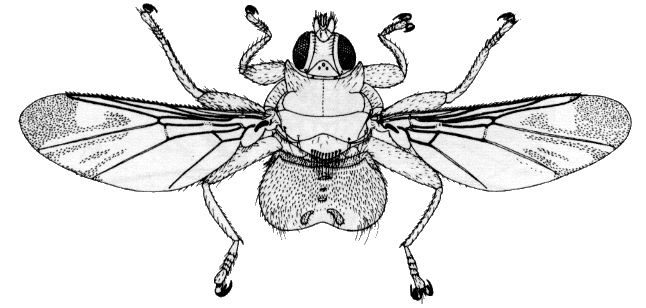 |
| Figure 120. Ornithomya avicularia, female in dorsal view. |
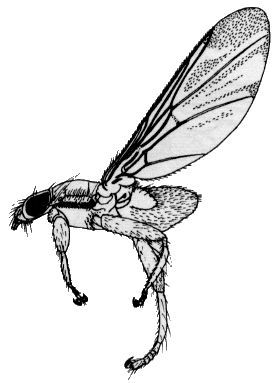 |
| Figure 121. Ornithomya avicularia, female in lateral view. |
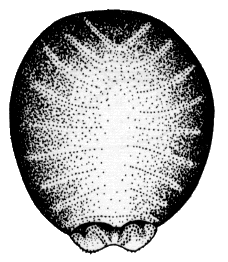 |
| Figure 122. Ornithomya avicularia, pupa. |
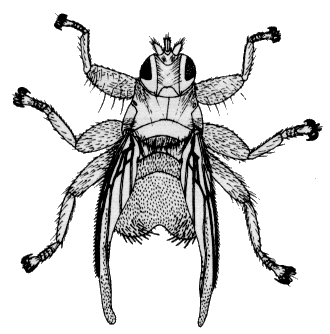 |
| Figure 123. Crataerina hirundinis, female in dorsal view. |
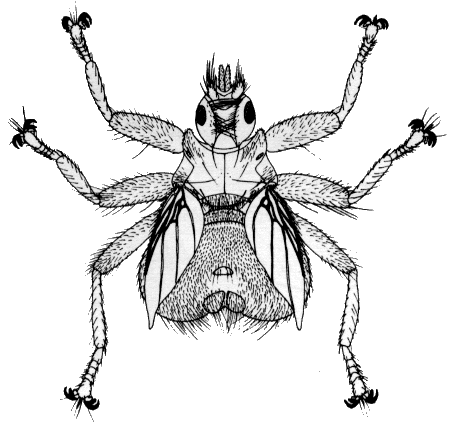 |
| Figure 124. Crataerina pallida, female in dorsal view. |
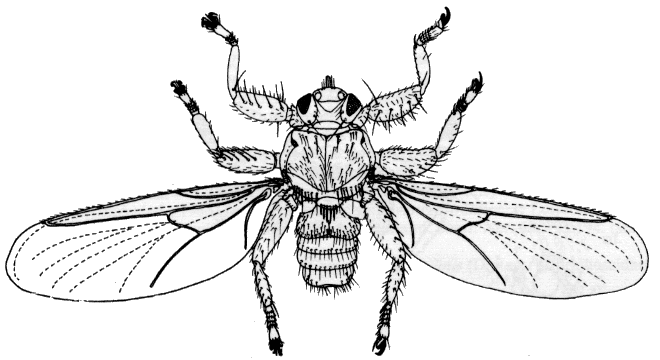 |
| Figure 125. Lipoptena cervi, alate female in dorsal view. |
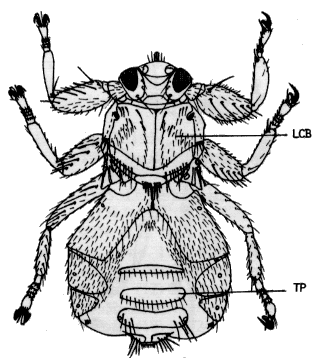 |
| Figure 126. Lipoptena cervi, dealate female in dorsal view. |
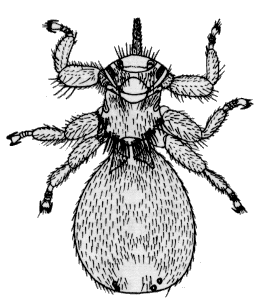 |
| Figure 127. Melophagus ovinus, female in dorsal view. |
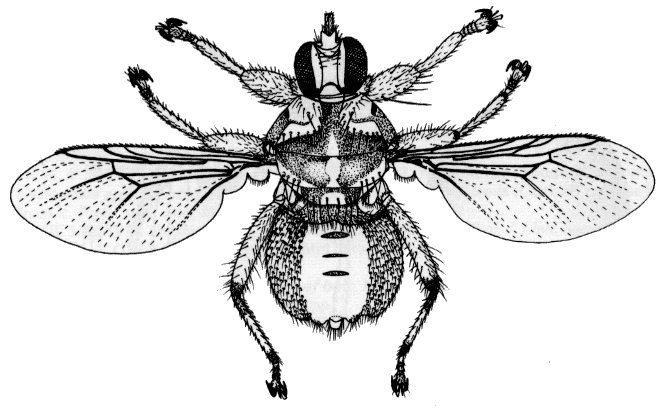 |
| Figure 128. Hippobosca equina, female in dorsal view. |
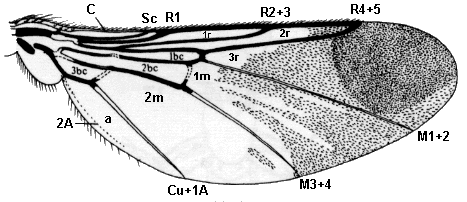 |
| Figure 129. Ornithomya chloropus, wing. |
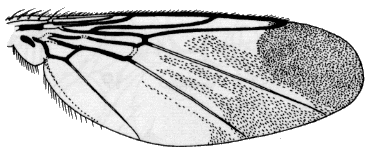 |
| Figure 130. Ornithomya fringillina, wing. |
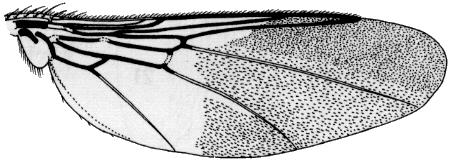 |
| Figure 131. Ornithomya biloba, wing. |
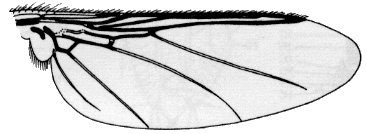 |
| Figure 132. Ornithophila metallica, wing. |
 |
| Figure 133. Icosta ardeae, wing. |
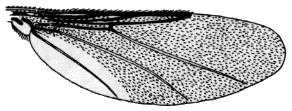 |
| Figure 134. Icosta minor, wing. |
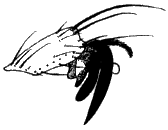 |
| Figure 135. Ornithomya avicularia, claw hind tarsus. |
 |
| Figure 136. Lipoptena cervi, claw hind tarsus. |
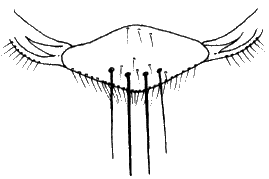 |
| Figure 137. Ornithomya fringillina, scutellum. |
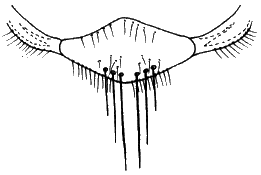 |
| Figure 138. Ornithomya chloropus, scutellum. |
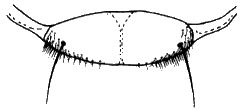 |
| Figure 139. Icosta ardeae, scutellum. |
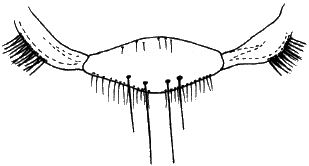 |
| Figure 140. Ornithoctona laticornis, scutellum. |
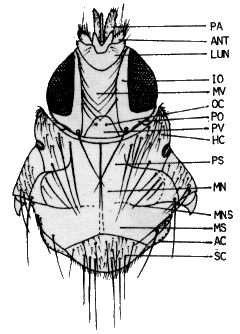 |
| Figure 141. Ornithomya biloba, head and thorax in dorsal view. |
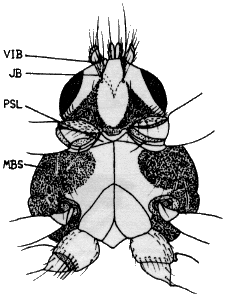 |
| Figure 142. Ornithomya chloropus, head and thorax in ventral view. |
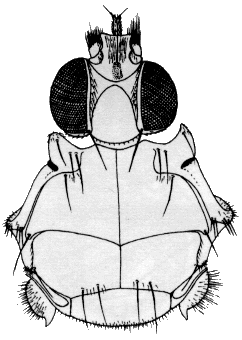 |
| Figure 143. Olfersia fumipennis, head and thorax in dorsal view. |
![[No image caption given.]](../../infusions/keys/figures/12_hippob25.gif) |
| Figure 144. [No image caption given.] |
![[No image caption given.]](../../infusions/keys/figures/12_hippob26.gif) |
| Figure 145. [No image caption given.] |
























![[No image caption given.]](../../infusions/keys/figures/12_hippob25.gif)
![[No image caption given.]](../../infusions/keys/figures/12_hippob26.gif)
























![[No image caption given.]](../../infusions/keys/figures/12_hippob25.gif)
![[No image caption given.]](../../infusions/keys/figures/12_hippob26.gif)